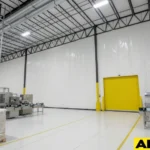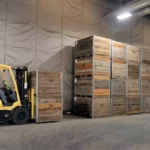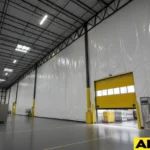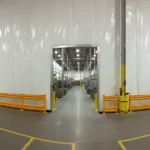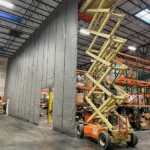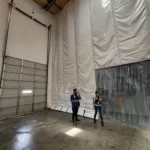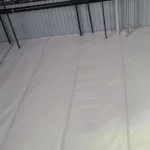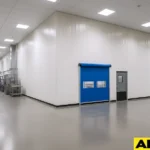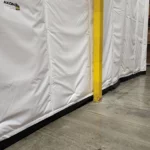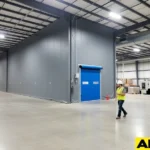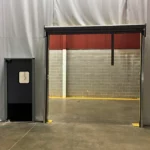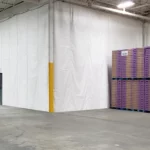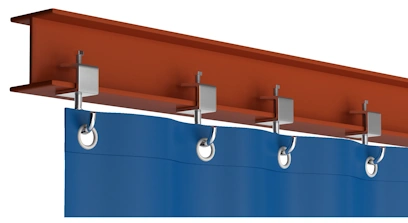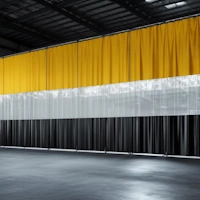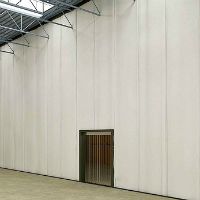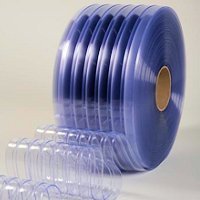
Overview
Akon insulated warehouse curtains allow you to partition and divide your floor space for temperature and humidity control. Unlike fixed rigid walls, the insulated panel curtains can be taken down when reconfiguring for new projects or when they're simply no longer needed. These insulated curtain walls are often times 1/3rd the cost of fixed rigid panel walls and much quicker to install.
Applications
Temperature Zoning
Create temperature zones for storing products at different temperatures or to create a more comfortable work environment.
Humidity Control
Effectively control humidity levels within your facility for food products or for better manufacturing processes.
Separate Tenants
Zone or lease out your warehouse to tenants who need to be kept separated due to their different operations.
Control Noise
Insulated curtains are also dual purpose noise control curtains due to the thick batting they are made from.
Temperature and Humidity Zoning
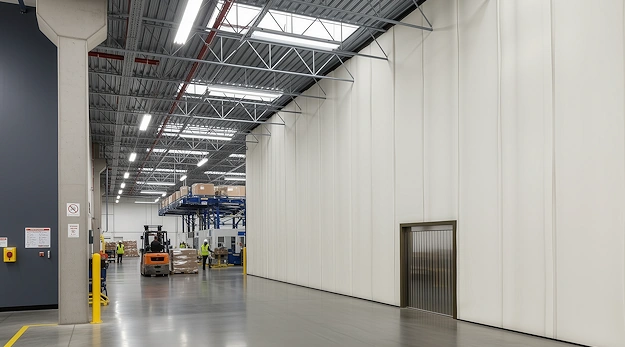
Temperature Benefits
- Create temperature zones for employee comfort
- Create temperature zones for food products or materials
- Easy to install behind your loading dock to save heat/cold loss
- Keeps consistent temperatures in various zones to save energy
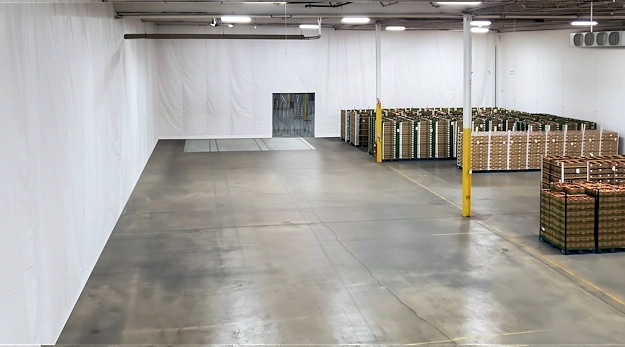
Humidity Benefits
- Ideal for food distribution plants to preserve quality of food
- Increases comfort for employees
- Curtain walls have Vinyl skins which contain condensation
- They have anti-microbial agent to prevent mold or mildew
- Allows chilling equipment to operate using less energy
Create Temperature Control Work Zones
Manage and Zone Work Flow
- Allows you to design and redesign temperature spaces
- If storage needs change, the walls can be easily moved
- Make spaces larger or smaller with modular 5′ wide panels
- If not needed, the entire wall can be stored in pallet boxes
- Unlike fixed walls no demolition is needed for redesign of layout
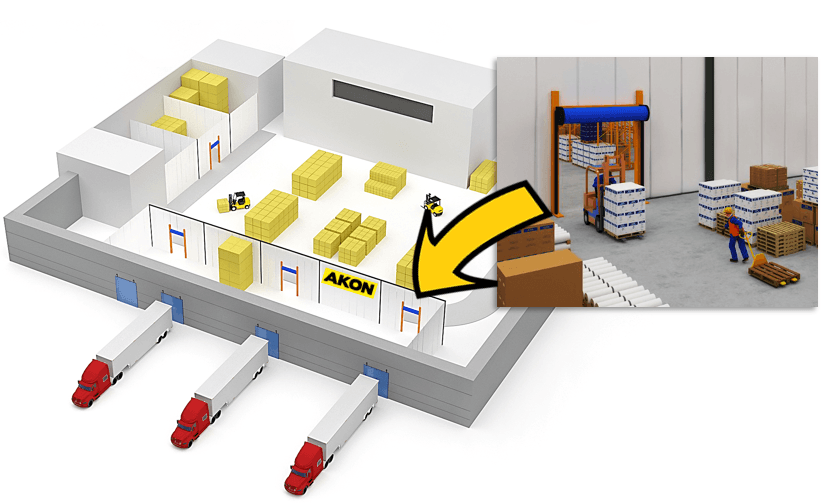
Create Tenant Separation
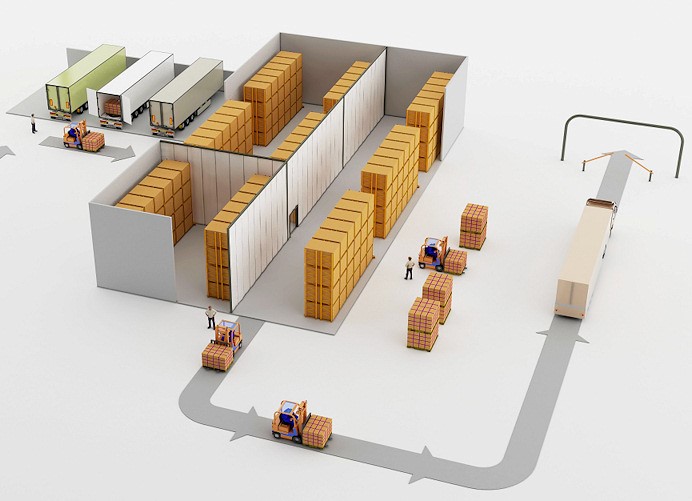
Manage and Zone Tenants
- Keeps warehouse lease tenants zones and separated
- Warehouse insulated curtains are ideal for temporary tenants
- If you lease out your warehouse, the curtains can divide work space
- They are also ideal at creating work areas for designated products
- After the lease is over the curtain walls can be taken down and stored
- The soft curtain walls can also be reconfigured for future lease tenants
Section Warehouse Space Quickly
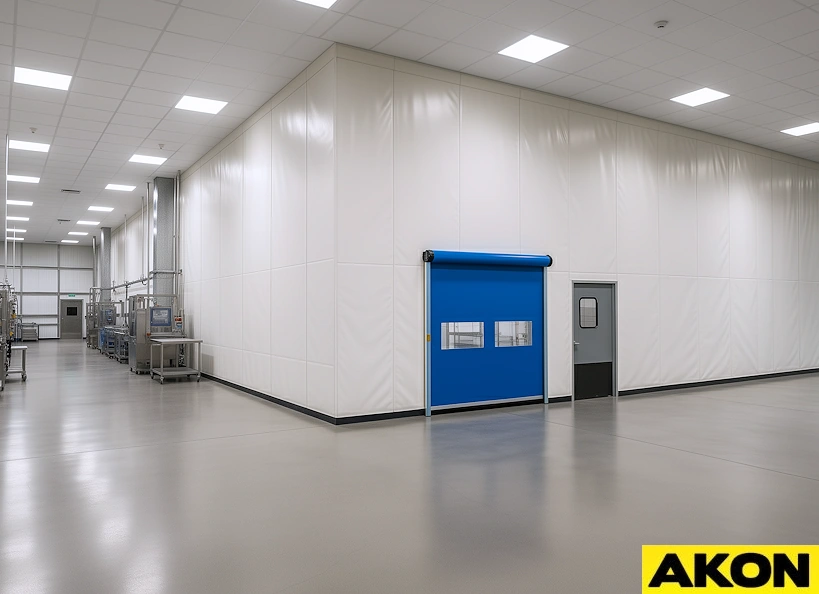
Construction and R-Values

Construction
The industrial insulated curtains have a thermal batting inside of two outer layers of reinforced Vinyl. The material is fire retardant to meet requirements set forth by most local and state regulations. Batting thickness depends on your required warehouse temperature separating needs.
R-Values
AKON insulated curtains can provide temperature separation up to 40F. The thicker the batting, the higher the R-value you will achieve. We help you determine which R-value to choose based on your desired temperature zones and the duration you will need to use the insulated warehouse dividers. For instance, if your needs are short term, it is best to choose a lower R-value to reduce your expense.
Quick Installation
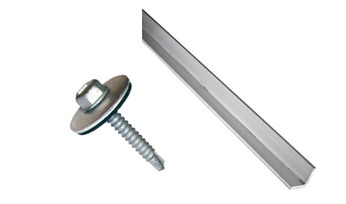
Installing The Curtains
The curtains come in ‘5 wide panels that Velcro together from top to bottom. Once connected they form walls that can be in almost configuration. They run from the roof deck to the floor, or from the bottom of the joists to the floor. Aluminum angle is the most common mounting method as it quickly attaches to the roof deck. You simply connect the angle to the structure and then use Tek screws with washers to pinch the curtain panels every 12″ to the angle. Need an installer? Ask AKON for one of our national installers to install your wall.
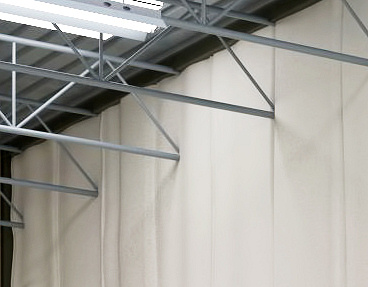
Seals Around Obstructions
Most curtain installations run all the way to the roof deck for a complete environmental seal and separation of environments. It is not uncommon with this type of installation to have to cut around purlins, joists, conduit and other obstructions. The curtains are made to be field cut and AKON provides special field patch tape to seal them back together at the split. It is very quick and very cost effective.
Entry and Exit Options
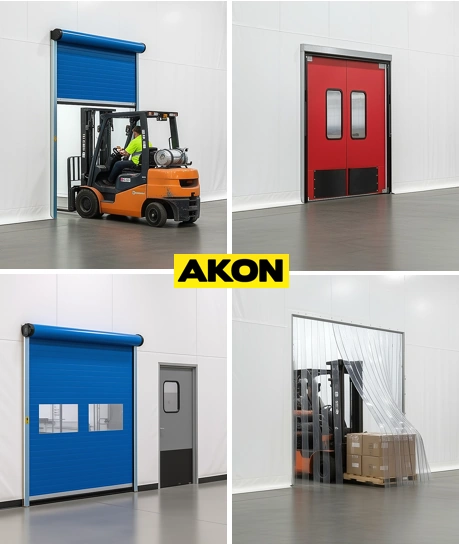
Entry Options
Insulated warehouse dividers are static position curtains. That means they do not roll side to side to allow people or material in. Rather, the curtains feature entry and exit locations. The most common entry and exits are strip curtains, swinging doors or powered roll up doors. Strip doors being the most common and economical. Each version features a freestanding frame that anchors into the floor and seals to the curtain wall.
Your Design Becomes Reality
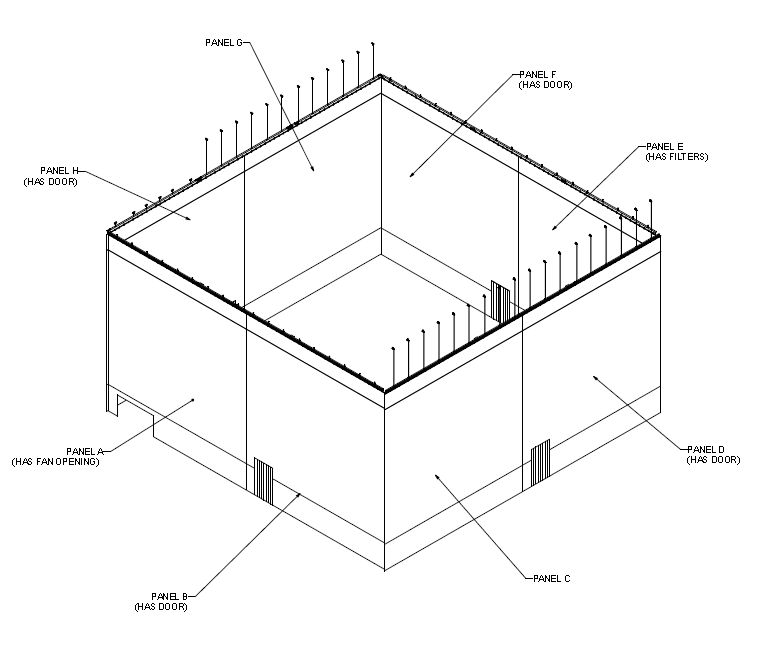
From Design To Install
AKON is the industry leader in warehouse separation curtains. Our company can take your design from concept to shipping in only 10 working days. We closely with industrial engineers and small business owners to take their objectives and turn them into reality.
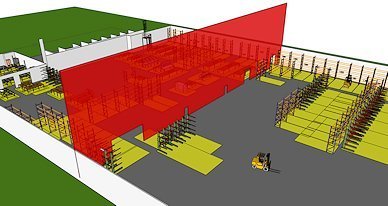
Photo Gallery
Frequently Asked Questions
Insulated warehouse curtains can help keep large spaces at a comfortable temperature and lower energy costs. These curtains make it easier to manage the temperature by separating warm and cool areas. They also help employees work better by cutting down on noise. Warehouses often put them up to keep their stock safe from changes in temperature and to save money on heating and cooling costs. The materials used to make these curtains keep the heat in and are strong enough to use every day. The FAQ section below talks about how these curtains work, what materials are usually used, and why they are useful for running a warehouse.
Insulated Warehouse Curtains
What are insulated warehouse curtains?
Insulated warehouse curtains are flexible thermal barriers made from vinyl and padded insulation. They help divide temperature zones, improve energy efficiency, and maintain consistent conditions across industrial or storage areas.
How do insulated warehouse curtains work?
They work by creating a sealed wall that slows heat transfer between spaces. The insulated core keeps air temperatures stable, lowering energy costs in large facilities where climate control is important.
What materials are used in insulated warehouse curtains?
Most insulated curtains are made from heavy-duty vinyl with polyester or foam insulation inside. These materials offer strong temperature resistance, moisture control, and long-term durability.
Can insulated curtains replace permanent walls?
Yes. They can serve as an alternative to permanent walls by providing similar temperature separation with easier installation and lower cost. Plus, they can be reconfigured when layouts change.
Do insulated curtains help reduce energy use?
Yes. By limiting the exchange of warm and cold air, insulated curtains lower energy waste and reduce HVAC workloads, resulting in noticeable savings over time.
Are insulated curtains suitable for cold storage?
Yes, they are ideal for cold storage or refrigerated environments. The insulation core helps maintain low temperatures and prevent warm air infiltration between zones.
Can I customize the size and insulation thickness?
Yes, all insulated curtains are custom-made. You can choose the exact height, width, color, insulation rating, and hardware options for your facility’s needs.
How are insulated warehouse curtains installed?
Installation is simple. Curtains hang from a ceiling or track system using rollers or hooks. They can be mounted quickly with standard tools and minimal disruption to workflow.
Can insulated curtains be reconfigured or moved?
Yes. Their modular design allows panels to be repositioned or relocated as floor plans evolve. This flexibility is one of the biggest advantages over solid walls.
Do insulated curtains reduce noise?
Yes. The insulated padding also absorbs sound, lowering noise levels from machinery and equipment. This creates a quieter and safer workspace for staff.
Are insulated warehouse curtains fire resistant?
Yes. The vinyl materials used meet NFPA fire standards and are self-extinguishing. Additional fire-retardant coatings can be added for extra protection if required.
Can forklifts pass through insulated curtains?
Yes, access openings can be integrated into the design, including sliding sections or strip doors, allowing forklifts and personnel to move freely between zones.
Are insulated curtains weather resistant?
Yes. The vinyl surface resists drafts, condensation, and temperature extremes, making these curtains effective in loading docks or semi-outdoor environments.
How do insulated curtains compare to air doors?
Insulated curtains provide better long-term temperature separation than air doors, especially for large openings, while costing less to operate and requiring no electrical components.
Do insulated curtains meet food safety or cleanroom standards?
Yes. Smooth, non-porous vinyl surfaces meet hygiene standards for food handling, storage, and pharmaceutical facilities, making them safe for controlled environments.
Can insulated curtains be used outdoors?
They are primarily for indoor use, but heavy-duty outdoor versions with UV protection can be made for partially enclosed areas like loading docks or warehouses with open bays.
What is the expected lifespan of insulated curtains?
With regular maintenance, insulated warehouse curtains can last for many years. Their reinforced materials resist wear and hold up well in demanding conditions.
How should insulated curtains be cleaned?
Cleaning is simple. Wipe with mild soap and water using a soft cloth. Avoid harsh chemicals that could damage the vinyl or reduce insulation efficiency.
Can insulated curtains be repaired if damaged?
Yes. Small punctures or tears can often be patched easily without replacing the entire panel, keeping maintenance costs low and downtime minimal.
What is the lead time for insulated warehouse curtains?
Most custom orders ship within one to two weeks, depending on size and complexity. Rush production and fast shipping options are available when needed.
R-Values
- R3 - 15°F of temperature separation
- R6 - 25°F of temperature separation
- R9 - 35°F of temperature separation
- R15 - 40°F of temperature separation
Weight | Thickness
- R3 - .41 lbs/sq ft | .60" Thick
- R6 - .48 lbs/sq ft | 1" Thick
- R9 - .82 lbs/sq ft | 4.2" Overall Thickness (Two R3 panels with a 3" air gap between them)
- R15 - .96 lbs/sq ft | 5" Overall Thickness (Two R6 panels with a 3" air gap between them)
Fire Codes
- Fire retardant: Exterior and interior ASTM E84 Class A Rating
Specifications
- 5 feet wide panels
- Full length industrial grade Velcro on panels for connecting
- Grommets on 12 inch centers at top of each panel
- Temperature range: -20° F to 160° F
- Skins: 19 oz acrylic coated vinyl exterior vinyl
- Batting: Double batting antimicrobial core
- 6" floor sweep to engage floor

